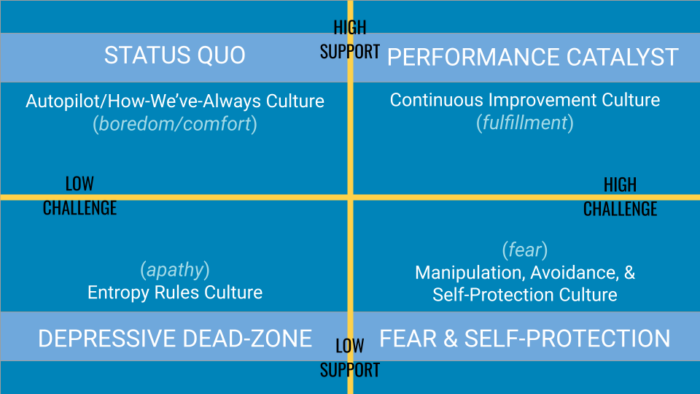Improve accountability with Support vs. Challenge
You want to improve accountability in your team.
This is the third and final installment of our Leader’s Accountability Guide. Did you miss the first or the second installment in this series? You’ll get more out of this entry if you go back and read those first.
In installment one, we named some common surprises and frequent mistakes that well-intentioned leaders make in trying to improve accountability.
In installment two, we got clarity about Clarity in the Accountability Culture Equation.
Clarity + Support + Challenge = Accountability Culture
Clarity established. So now…
Check out this matrix. It illustrates when what happens in different combinations of support and challenge (or their absence). Then we’ll dig in on what support and challenge look like.

Support Second
Once you’ve got clarity, it’s time to assure our people that they’re not on their own. They’ve joined a team. Someone — better yet, everyone — has got their back.
Simon Sinek, in Leaders Eat Last, does a great job of laying out the scientific case for support. He demonstrates, teams will not pull together in places where people do not feel safe, supported, and cared for. In fact, neuro-chemically, people who feel under threat will not be accountable. In order to make it easy to repel threats, their brains will switch into self-protection mode. This is not a choice on their part. It’s not selfishness, not a character flaw. Actually, it’s not really a choice. For the brain of someone who feels unsafe, self-interest is a biological imperative.
Accountability is a state of vulnerability, and people don’t do vulnerability when they’re in danger.
How to Support
Consider this. Support is key to building the trust and a sense of psychological safety. Trust and psychological safety, in turn, are required to inspire accountability.
In other words, support is a prerequisite of accountability. That’s because accountability is a choice to be vulnerable, and a brain that feels under threat will not choose to open-up under a condition of threat. The brain considers that giving the knife to the enemy.
A brain that feels protected, safe, and supported is the only brain free to choose accountability.
In order to create an environment of support, we’ve got to know what that looks like. It includes policies and procedures that acknowledge the humanity of your team. Support requires that you adopt business practices and HR polices that are consistent with the organization’s professed values. (In too many companies, for instance, “TRUST” is listed as a core value. And then the employee handbook is full of policies that belie profound mistrust in the employee — by default.) Support includes everyone on the team looking out for one another and stepping in to help if someone stumbles. In a high-support environment, leaders give specific praise for a job well done, and constructively crafted suggestions for improvement when needed.
Here are some ways supportive leaders express their support directly to the folks on their team:
- What are your career goals? How can I help you get there?
- What are your expectations of me?
- Do you have what you need? (I may not always be able to give you the tools you want, I always want to know what would help.)
- I have confidence in you.
- Let’s make sure we have clarity around the priorities so you know what most needs your attention.
- Failing happens. Failing is expected. Fail forward.
- Yesterday’s presentation was far better than last month’s. I can see you took my feedback to heart and improved your slides and your speaking cadence.
- How’s your family? (You know names, by the way.)
- What obstacles do you see coming down the pike? How can I help ensure your success?
To be effective in inspiring accountability, support must not be occasional, sporadic, or inconsistent. Effective support is frequent, regular, and consistent. It’s specific. It’s so common as to be the norm. People who’ve been working in a supportive environment learn to expect support. And give it. Support becomes the rule. Like gravity.
Why do we trust gravity implicitly? Because, it’s always there.
Here’s the code of accountability…
When my team and the structures we work within have my back and I know it, then I will readily embrace accountability.
Clarity + Support + Challenge = Accountability Culture
Challenge Third
Relationships built on reliable support can — errm… ah — support a hefty dose of challenge without cracking under the strain. Support helps people to know they belong, that they’re accepted, and that they will not be hung out to dry. And secure in that knowledge, people will accept and welcome challenge that presses them to improve. When supported AND challenged, people willingly reach for levels of excellence, initiative, and productivity they haven’t reached before. They take risks.
In the military, they have a saying for accepting the pain of growth and commitment to purpose. They say, “Embrace the suck.”
When you think back through your life, who are the people — the teachers, coaches, leaders — who made the biggest difference in your life? For me, they’re the people who knew how and when to support me. And they knew how and when to challenge me.
- They knew I was capable of more. They calmly insisted that I step into that capability.
- They calmly insisted that my teammates step into the capabilities that their roles required.
- They invited us to embrace the suck. They insisted… gently and firmly.
- They did not lower standards to meet us. They lifted us to meet high standards.
That combination of support and challenge fills people with a sense of surety and courage. As a combo, it’s a steady hand on their back, ensuring they don’t fall backward and also that they take the next step forward.
In the context of accountability, what does challenge look like? Challenge includes making it clear that accountability is a requirement for being and remaining on the team.
Requirement? You may be thinking, “But in the first installment of this guide, you said we can’t hold others accountable. It’s a personal choice.”
Indeed.
In an environment of healthy challenge, challenge is often framed in the form of a choice. The choice is between:
- Embracing accountability and remaining on the team on the one hand, and
- Refusing accountability and allowing the team to move on without you on the other hand.
Do not think, “drill sergeant.” Challenge in the context of support is not about hard, loud edges or emotionality. Think instead, “physical therapist.”
A physical therapist requires that we get uncomfortable. They’re compassionate. And they’re firm.
“I know it hurts. Do it anyway. Just a little further than last time. Now hold it. Hold it a little longer. No. Don’t let up. Good. Now rest.”
Can you imagine the scene with this physical therapist? Read it again. Imagine.
“I know it hurts. Do it anyway. Just a little further than last time. Now hold it. Hold it a little longer. No. Don’t let up. Good. Now rest.”
In your imagination, is the physical therapist angry about the patient’s resistance? Is the PT raising their voice in response to expressions of fear or pain? Is the PT making space for refusal?
Short Story
I remember the physical therapist in the hospital after I’d had surgery on my leg. She insisted on seeing me walk down the hall on crutches. The crutches were easy. Being upright after surgery, on the other hand, not so much. That was very painful.
“You don’t have to do it right now,” she said. “And, I can’t let you go home until you walk all the way down the hall and back. And you have go up and down three stairs. I have to see you do that before we discharge you. You worry about the crutches and the walking. I’ll wheel your IV bag along beside you and make sure you don’t fall.” The choice was mine. I could a) walk and go home where I wanted to be. Or I could, b) refuse to walk and stay in the hospital longer.
Easy choice.
Very difficult walk.
Easy choice.
Total support. Total challenge.
So what does challenge look like in a work leadership situation?
- This is the standard. Please meet the standard.
- The gap between your performance and the standard is X. How do you plan to close that gap?
- I know growth from A to B doesn’t happen overnight. Here’s a timeline by which I’d like to see you reach B.
- What are your goals? How are you getting in your own way?
- What is the next step in continuous improvement for us? How will you contribute?
- You committed to Z. You didn’t deliver Z.
- You committed to Q. The deadline is coming up. How’s that coming? Please be specific. Are you on schedule?
- “What would greatness look like right now?” (from Cy Wakeman’s book, No Ego)
- Gently refuse to take back any “problem” that is theirs to solve. (You can use our smart leader’s SMART model for doing this.)
How can you challenge without degrading support or breaking trust? Challenge in support.
I once heard someone say — and I loved it — “Instead of calling people out, call them UP.”
In the context of support, when I am held to a high standard and challenged to meet it, then I am strongly inclined toward accountability.
How to Improve Accountability In Your Team?
Let’s review.
Clarity + Support + Challenge = Accountability Culture
Using clarity and specificity, ensure you and your team are on the same page. Get there by separating the components of accountability.
- Responsibility: What’s the job? What are the expectations? What is the standard?
- Reliability: Did you do what you said you’d do? Are you delivering on your responsibilities?
- Effectiveness: How will we know if you are successful? Did you get the results we were looking for?
- Ownership: Are you ready, willing, and able to look for, identify, and own the connection between your actions and the results they delivered.
Next, support people through care, training, expressions of compassion. Be interested in their lives and their goals. Share your confidence in them.
Challenge people to meet a high standard. Ask them to push their capabilities and to be better tomorrow than they are today. Require them to take on new responsibilities, and to own their effective execution.
Successfully inspiring accountability is not about balancing these ingredients one against the other, trying to find that perfect mix. A little more of this… A little less of that.
Accountability, personal fulfillment, and exceptional performance result from marrying clarity, support and challenge. Strive to be high in all three. Extremely clear. Wicked supportive. Highly challenging.
You will love the results. Your team will love you. They’ll love each other. And, they’ll love themselves more.
I’ll leave you with this new equation. Accountability = self love.

